Method and apparatus for maxillo-mandibular fixation
a technology for mandibular fixation and maxilla, which is applied in the field of method and apparatus for maxilla mandibular fixation, can solve the problems of presenting a real risk of needle sticks and gloves, a fairly elaborate wiring scheme which can only be released with wire cutters, and a very time-consuming and laborious wiring techniqu
- Summary
- Abstract
- Description
- Claims
- Application Information
AI Technical Summary
Problems solved by technology
Method used
Image
Examples
Embodiment Construction
[0019]Mandibular and maxillary bones are made of hard, dense cortical bone into which tooth roots extend and interdental tissue between the teeth themselves. The interdental spaces consist of gingival mucosa and soft tissue and the edge of the alveolar bone, which is spongy and not particularly dense or strong. This interdental tissue has not generally been considered by those of ordinary skill in the art as being strong enough to provide enough fixation strength to accomplish MMF. However, the inventor has discovered and discloses herein methods and apparatus which permit the interdental space to be used for MMF, thus avoiding the inconveniences and dangers of traditional approaches.
[0020]Referring now to the drawings which form a part of this disclosure, in one embodiment, a base component 10 made of steel, titanium or plastic, or other such material is attached to the distal end 14 of an elongate member 12. The base component 10 may be threaded onto the member or otherwise remova...
PUM
 Login to View More
Login to View More Abstract
Description
Claims
Application Information
 Login to View More
Login to View More - R&D
- Intellectual Property
- Life Sciences
- Materials
- Tech Scout
- Unparalleled Data Quality
- Higher Quality Content
- 60% Fewer Hallucinations
Browse by: Latest US Patents, China's latest patents, Technical Efficacy Thesaurus, Application Domain, Technology Topic, Popular Technical Reports.
© 2025 PatSnap. All rights reserved.Legal|Privacy policy|Modern Slavery Act Transparency Statement|Sitemap|About US| Contact US: help@patsnap.com



